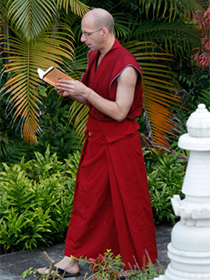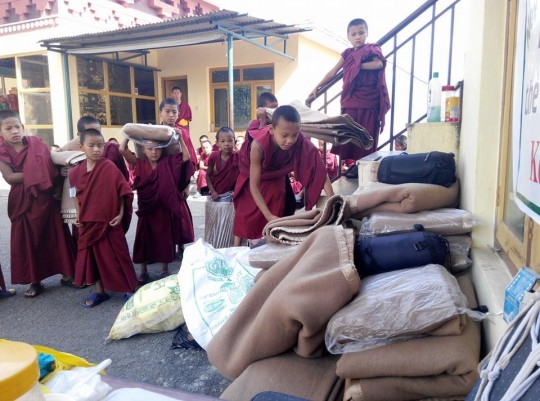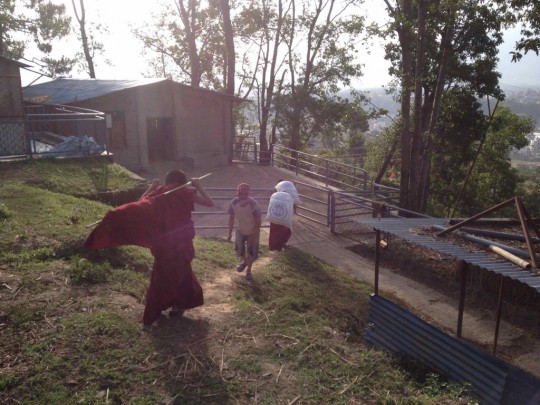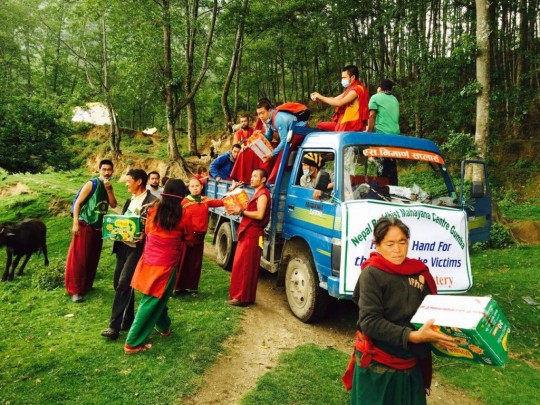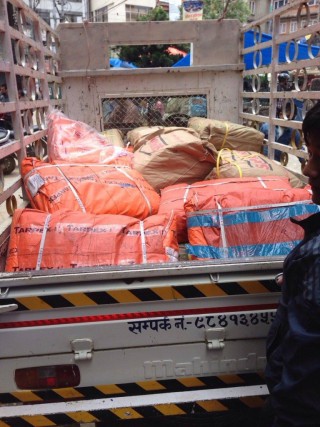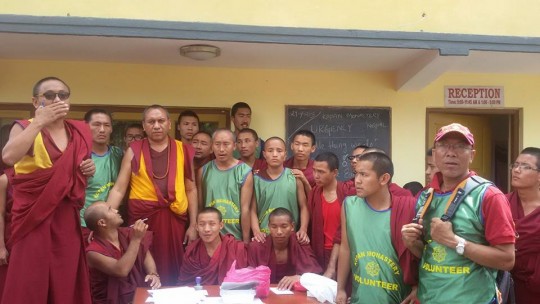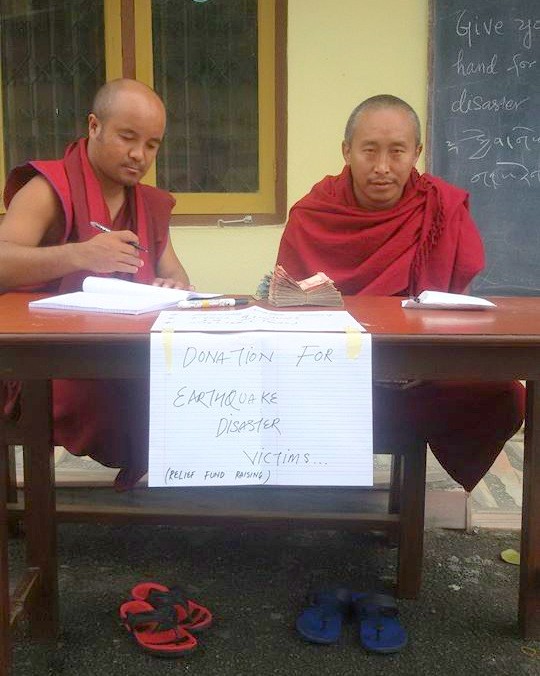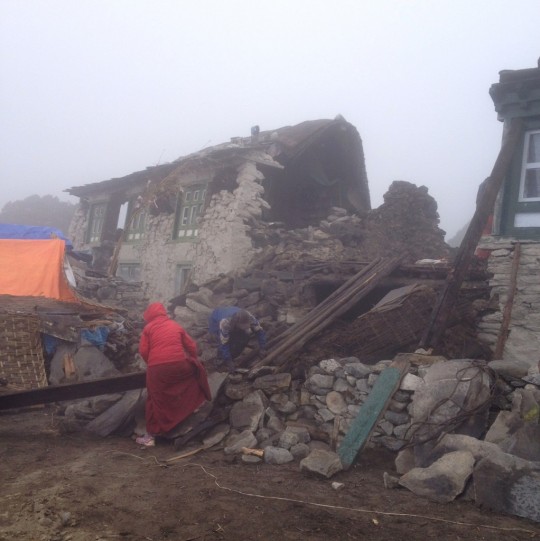- Home
- FPMT Homepage
Foundation for the Preservation of the Mahayana Tradition
The FPMT is an organization devoted to preserving and spreading Mahayana Buddhism worldwide by creating opportunities to listen, reflect, meditate, practice and actualize the unmistaken teachings of the Buddha and based on that experience spreading the Dharma to sentient beings. We provide integrated education through which people’s minds and hearts can be transformed into their highest potential for the benefit of others, inspired by an attitude of universal responsibility and service. We are committed to creating harmonious environments and helping all beings develop their full potential of infinite wisdom and compassion. Our organization is based on the Buddhist tradition of Lama Tsongkhapa of Tibet as taught to us by our founders Lama Thubten Yeshe and Lama Thubten Zopa Rinpoche.
- Willkommen
Die Stiftung zur Erhaltung der Mahayana Tradition (FPMT) ist eine Organisation, die sich weltweit für die Erhaltung und Verbreitung des Mahayana-Buddhismus einsetzt, indem sie Möglichkeiten schafft, den makellosen Lehren des Buddha zuzuhören, über sie zur reflektieren und zu meditieren und auf der Grundlage dieser Erfahrung das Dharma unter den Lebewesen zu verbreiten.
Wir bieten integrierte Schulungswege an, durch denen der Geist und das Herz der Menschen in ihr höchstes Potential verwandelt werden zum Wohl der anderen – inspiriert durch eine Haltung der universellen Verantwortung und dem Wunsch zu dienen. Wir haben uns verpflichtet, harmonische Umgebungen zu schaffen und allen Wesen zu helfen, ihr volles Potenzial unendlicher Weisheit und grenzenlosen Mitgefühls zu verwirklichen.
Unsere Organisation basiert auf der buddhistischen Tradition von Lama Tsongkhapa von Tibet, so wie sie uns von unseren Gründern Lama Thubten Yeshe und Lama Thubten Zopa Rinpoche gelehrt wird.
- Bienvenidos
La Fundación para la preservación de la tradición Mahayana (FPMT) es una organización que se dedica a preservar y difundir el budismo Mahayana en todo el mundo, creando oportunidades para escuchar, reflexionar, meditar, practicar y actualizar las enseñanzas inconfundibles de Buda y en base a esa experiencia difundir el Dharma a los seres.
Proporcionamos una educación integrada a través de la cual las mentes y los corazones de las personas se pueden transformar en su mayor potencial para el beneficio de los demás, inspirados por una actitud de responsabilidad y servicio universales. Estamos comprometidos a crear ambientes armoniosos y ayudar a todos los seres a desarrollar todo su potencial de infinita sabiduría y compasión.
Nuestra organización se basa en la tradición budista de Lama Tsongkhapa del Tíbet como nos lo enseñaron nuestros fundadores Lama Thubten Yeshe y Lama Zopa Rinpoche.
A continuación puede ver una lista de los centros y sus páginas web en su lengua preferida.
- Bienvenue
L’organisation de la FPMT a pour vocation la préservation et la diffusion du bouddhisme du mahayana dans le monde entier. Elle offre l’opportunité d’écouter, de réfléchir, de méditer, de pratiquer et de réaliser les enseignements excellents du Bouddha, pour ensuite transmettre le Dharma à tous les êtres. Nous proposons une formation intégrée grâce à laquelle le cœur et l’esprit de chacun peuvent accomplir leur potentiel le plus élevé pour le bien d’autrui, inspirés par le sens du service et une responsabilité universelle. Nous nous engageons à créer un environnement harmonieux et à aider tous les êtres à épanouir leur potentiel illimité de compassion et de sagesse. Notre organisation s’appuie sur la tradition guéloukpa de Lama Tsongkhapa du Tibet, telle qu’elle a été enseignée par nos fondateurs Lama Thoubtèn Yéshé et Lama Zopa Rinpoché.
Visitez le site de notre Editions Mahayana pour les traductions, conseils et nouvelles du Bureau international en français.
Voici une liste de centres et de leurs sites dans votre langue préférée
- Benvenuto
L’FPMT è un organizzazione il cui scopo è preservare e diffondere il Buddhismo Mahayana nel mondo, creando occasioni di ascolto, riflessione, meditazione e pratica dei perfetti insegnamenti del Buddha, al fine di attualizzare e diffondere il Dharma fra tutti gli esseri senzienti.
Offriamo un’educazione integrata, che può trasformare la mente e i cuori delle persone nel loro massimo potenziale, per il beneficio di tutti gli esseri, ispirati da un’attitudine di responsabilità universale e di servizio.
Il nostro obiettivo è quello di creare contesti armoniosi e aiutare tutti gli esseri a sviluppare in modo completo le proprie potenzialità di infinita saggezza e compassione.
La nostra organizzazione si basa sulla tradizione buddhista di Lama Tsongkhapa del Tibet, così come ci è stata insegnata dai nostri fondatori Lama Thubten Yeshe e Lama Zopa Rinpoche.
Di seguito potete trovare un elenco dei centri e dei loro siti nella lingua da voi prescelta.
- 欢迎 / 歡迎
简体中文
“护持大乘法脉基金会”( 英文简称:FPMT。全名:Foundation for the Preservation of the Mahayana Tradition) 是一个致力于护持和弘扬大乘佛法的国际佛教组织。我们提供听闻,思维,禅修,修行和实证佛陀无误教法的机会,以便让一切众生都能够享受佛法的指引和滋润。
我们全力创造和谐融洽的环境, 为人们提供解行并重的完整佛法教育,以便启发内在的环宇悲心及责任心,并开发内心所蕴藏的巨大潜能 — 无限的智慧与悲心 — 以便利益和服务一切有情。
FPMT的创办人是图腾耶喜喇嘛和喇嘛梭巴仁波切。我们所修习的是由两位上师所教导的,西藏喀巴大师的佛法传承。
繁體中文
護持大乘法脈基金會”( 英文簡稱:FPMT。全名:Found
ation for the Preservation of the Mahayana Tradition ) 是一個致力於護持和弘揚大乘佛法的國際佛教組織。我們提供聽聞, 思維,禪修,修行和實證佛陀無誤教法的機會,以便讓一切眾生都能 夠享受佛法的指引和滋潤。 我們全力創造和諧融洽的環境,
為人們提供解行並重的完整佛法教育,以便啟發內在的環宇悲心及責 任心,並開發內心所蘊藏的巨大潛能 — 無限的智慧與悲心 – – 以便利益和服務一切有情。 FPMT的創辦人是圖騰耶喜喇嘛和喇嘛梭巴仁波切。
我們所修習的是由兩位上師所教導的,西藏喀巴大師的佛法傳承。 察看道场信息:
- FPMT Homepage
- News/Media
-
- Study & Practice
-
-
- About FPMT Education Services
- Latest News
- Programs
- New to Buddhism?
- Buddhist Mind Science: Activating Your Potential
- Heart Advice for Death and Dying
- Discovering Buddhism
- Living in the Path
- Exploring Buddhism
- FPMT Basic Program
- FPMT Masters Program
- FPMT In-Depth Meditation Training
- Maitripa College
- Lotsawa Rinchen Zangpo Translator Program
- Universal Education for Compassion & Wisdom
- Online Learning Center
-
- Prayers & Practice Materials
- Overview of Prayers & Practices
- Full Catalogue of Prayers & Practice Materials
- Explore Popular Topics
- Benefiting Animals
- Chenrezig Resources
- Death & Dying Resources
- Lama Chopa (Guru Puja)
- Lama Zopa Rinpoche: Compendium of Precious Instructions
- Lama Zopa Rinpoche: Life Practice Advice
- Lama Zopa Rinpoche Practice Series
- Lamrim Resources
- Mantras
- Prayer Book Updates
- Purification Practices
- Sutras
- Thought Transformation (Lojong)
- Audio Materials
- Dharma Dates - Tibetan Calendar
- Translation Services
- Publishing Services
- Ways to Offer Support
- Prayers & Practice Materials
-
- Teachings and Advice
- Find Teachings and Advice
- Lama Zopa Rinpoche Advice Page
- Lama Zopa Rinpoche: Compendium of Precious Instructions
- Lama Zopa Rinpoche Video Teachings
- ༧སྐྱབས་རྗེ་བཟོད་པ་རིན་པོ་ཆེ་མཆོག་ནས་སྩལ་བའི་བཀའ་སློབ་བརྙན་འཕྲིན།
- Podcasts
- Lama Yeshe Wisdom Archive
- Buddhism FAQ
- Dharma for Young People
- Resources on Holy Objects
- Teachings and Advice
-
-
*If a menu item has a submenu clicking once will expand the menu clicking twice will open the page.
-
-
- Centers
-
- Teachers
-
- Projects
-
-
-
-
*If a menu item has a submenu clicking once will expand the menu clicking twice will open the page.
-
-
- FPMT
-
-
-
-
-
Don’t think of Buddhism as some kind of narrow, closed-minded belief system. It isn’t. Buddhist doctrine is not a historical fabrication derived through imagination and mental speculation, but an accurate psychological explanation of the actual nature of the mind.
Lama Thubten Yeshe
-
-
-
- Shop
-
-
-
The Foundation Store is FPMT’s online shop and features a vast selection of Buddhist study and practice materials written or recommended by our lineage gurus. These items include homestudy programs, prayers and practices in PDF or eBook format, materials for children, and other resources to support practitioners.
Items displayed in the shop are made available for Dharma practice and educational purposes, and never for the purpose of profiting from their sale. Please read FPMT Foundation Store Policy Regarding Dharma Items for more information.
-
-
Lama Zopa Rinpoche News and Advice
19
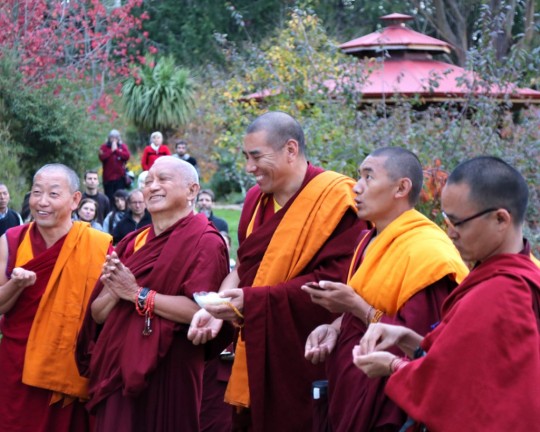
Lama Zopa Rinpoche, Geshe Wangchen and Geshe Tharchin blessing the large Buddha statue at Chandrakirti Centre, Nelson, New Zealand, May 2015. Photo by Ven. Thubten Kunsang.
“First, the I from beginningless rebirths – the way the I is perceived by us, it appears to us as truly existent, existing from its own side,” taught Lama Zopa Rinpoche at a refuge ceremony at Amitabha Buddhist Centre, Singapore in March 2013. “The real I appears like that. The real I is not in the head, not in the legs, not in the toes, not in the head, not in the brain, not in the nose, not in the ears, not in the fingers. The real I is not in the toes, not in the legs, not in the stomach, and not in the kaka. You are not living in the kaka. The real I is not living in your throat; it’s not in the beating heart. What else is there? The real I is not in the lungs. We can’t find it; we can’t find any details; we can’t find it in any detailed place. When we check, the real I is not anywhere. Normally we think it is here, we point here [to the chest]. Happy or sad, we point here. Or if somebody says: “Are you telling me? Me!” We always point there.
“When we don’t examine, when we are not aware, it is like that. We are following the wrong concept, ignorance, holding I, action, object, everything, as truly existent, in particular, somewhere in the chest, somewhere there. But when we look for it; when we check in the heart, liver, lungs, the real I is nowhere to be found.
“For this real I to be happy, we do all kinds of things. If we have power, we make wars and kill millions, millions, millions of people. This has happened already, many times in this world. That is in a big way. Then in a small way, we kill the enemy to get happiness for this I, for the real I. But when we look for it, if we go through an x-ray or we are in the hospital and our body is cut open, we cannot find it. But believing it is there, we kill many millions of people in the world, or we kill just one person, the enemy. Killing, stealing, sexual misconduct, telling lies, all the alcohol – all this is to get happiness for this real I, which is not there. From the hair down to the toes, it cannot be found at all.
“In daily life, the hallucination is there, somewhere there, in the chest, one hundred percent, no question. No question, we believe it one hundred percent. Then we do everything for that, to get happiness for that – even negative karma, anything, telling lies, cheating. Our whole life is spent like that, to get happiness for this I. Even in business, we cheat others to get happiness for this I. If somebody criticizes us or blames us, then we make a court case and we put them in prison. We spend so much money on court cases, to put others in prison, we do anything we can to the person we don’t like or who harms us.
“Can you imagine, how we use our whole life is like that, to get happiness for the real I which we can’t find there? This real I is not there. We can’t find it anywhere. Life is like that, a hallucination, a total hallucination. It is very interesting to really check the life.”
Excerpted from “Seeing How the I Exists” (http://bit.ly/seeing-how-the-i-exists) made available by the Lama Yeshe Wisdom Archive.
Learn more about Lama Zopa Rinpoche, spiritual director of the Foundation for the Preservation of Mahayana Tradition (FPMT), and Rinpoche’s vision for a better world. Sign up to receive news and updates.
Video of Rinpoche’s teachings from New Zealand, both live and recorded, can be found on FPMT’s Livestream page.
To learn more and offer support to FPMT’s Nepal Earthquake Support Fund, which will be used for immediate relief and rebuilding, visit:
https://fpmt.org/support/socialservices/
For “Prayers and Practice for Earthquake in Nepal,” see:
https://fpmt.org/edu-news/prayers-and-practices-for-earthquake-in-nepal/
For continuing updates and news from Kopan Monastery and other FPMT centers and projects in Nepal affected by the earthquake, please visit our “Updates from Nepal after the Earthquake” page:
https://fpmt.org/nepal-earthquake/
- Tagged: lama yeshe wisdom archive, lama zopa rinpoche
- 0
18
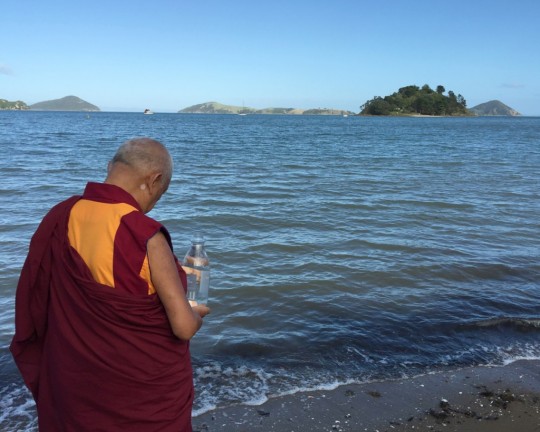
Lama Zopa Rinpoche blessing the sentient beings in the ocean before Auckland flight to Nelson, New Zealand, May 2015. Photo by Ven. Thubten Kunsang.
On May 15, Ven. Roger Kunsang shared this from Lama Zopa Rinpoche’s teachings at Chandrakirti Centre on his Twitter page:
Lama Zopa: Nothing happens by itself without causes and conditions. Outside is a condition, not the principal cause. Most think outside.
Ven. Roger Kunsang, Lama Zopa Rinpoche’s assistant and CEO of FPMT Inc., shares Lama Zopa Rinpoche’s recent pith sayings on Ven. Roger’s Twitter page. (You can also read them on Ven. Roger’s Facebook page.)
Lama Zopa Rinpoche’s teachings at Chandrakirti Centre can be watched now on FPMT’s Livestream page.
For continuing updates and news from Kopan Monastery and other FPMT centers and projects in Nepal affected by the earthquake, please visit our “Updates from Nepal after the Earthquake” page:
https://fpmt.org/nepal-earthquake/
To learn more and offer support to the Nepal Earthquake Support Fund visit:
https://fpmt.org/support/socialservices/
For “Prayers and Practice for Earthquake in Nepal,” see:
https://fpmt.org/edu-news/prayers-and-practices-for-earthquake-in-nepal/
More information, photos and updates about FPMT spiritual director Lama Zopa Rinpoche can be found on Rinpoche’s homepage. If you’d like to receive news of Lama Zopa Rinpoche via email, sign up to Lama Zopa Rinpoche News.
- Tagged: animals, lama zopa rinpoche, new zealand, twitter
- 0
14
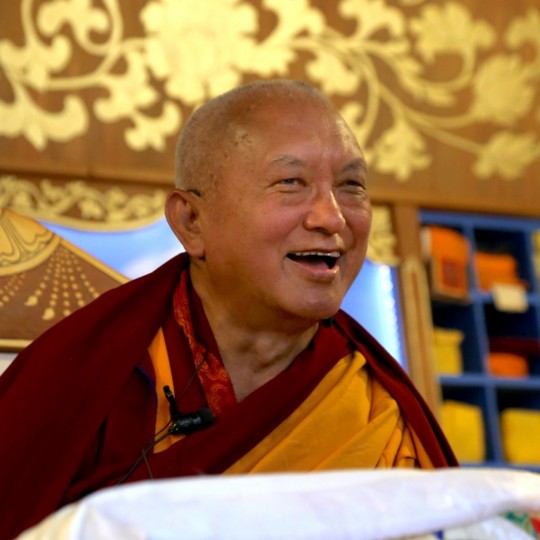
Lama Zopa Rinpoche teaching at Mahamudra Centre, New Zealand, May 2015. Photo by Ven. Thubten Kunsang.
On May 10, Ven. Roger Kunsang shared this from Lama Zopa Rinpoche’s teaching at Mahamudra Centre on his Twitter page:
Lama Zopa: Thought transformation is not to stop the problem. It is to use it to make it highly beneficial in the path to enlightenment.
Ven. Roger Kunsang, Lama Zopa Rinpoche’s assistant and CEO of FPMT Inc., shares Lama Zopa Rinpoche’s recent pith sayings on Ven. Roger’s Twitter page. (You can also read them on Ven. Roger’s Facebook page.)
Lama Zopa Rinpoche’s teachings at Mahamudra Centre can be watched now on FPMT’s Livestream page.
For continuing updates and news from Kopan Monastery and other FPMT centers and projects in Nepal affected by the earthquake, please visit our “Updates from Nepal after the Earthquake” page:
https://fpmt.org/nepal-earthquake/
To learn more and offer support to the Nepal Earthquake Support Fund visit:
https://fpmt.org/support/socialservices/
For “Prayers and Practice for Earthquake in Nepal,” see:
https://fpmt.org/edu-news/prayers-and-practices-for-earthquake-in-nepal/
More information, photos and updates about FPMT spiritual director Lama Zopa Rinpoche can be found on Rinpoche’s homepage. If you’d like to receive news of Lama Zopa Rinpoche via email, sign up to Lama Zopa Rinpoche News.
- Tagged: lama zopa rinpoche, twitter
- 0
13

Lama Zopa Rinpoche after landing at Nelson on New Zealand’s South Island on the way to Chandrakirti Centre, May 2015. Photo by Ven. Thubten Kunsang.
Lama Zopa Rinpoche traveled from New Zealand’s North Island to its South Island to continue his teaching tour, which is being made available as much as possible via web streaming. Video of these teachings, both live and recorded, can be found on FPMT’s Livestream page.
On May 16-17, Rinpoche teaches at Chandrakirti Centre. FPMT’s media team is hoping to be able to offer a live webcast of these teachings, but are still checking to see whether the internet bandwidth quality will be strong enough. You can sign up to receive updates on FPMT’s Livestream page (click the green “Follow” button).
Rinpoche’s teachings in Auckland at Dorje Chang Institute will be streamed live:
- May 22: Teaching on How to Have a Happy, Meaningful Life, schedule to start at 7 pm New Zealand time
- May 23: Teaching on How to Have a Happy, Meaningful Life, 4 – 7 pm New Zealand time
- May 25: A Chat about Death, approximately 3 – 5 pm New Zealand time
Rinpoche’s teachings at Mahamudra Centre can be watched now on Livestream.
Higher quality recordings will be made available at a later date on Rinpoche Available Now.
See Rinpoche’s Schedule for more details of the teachings.
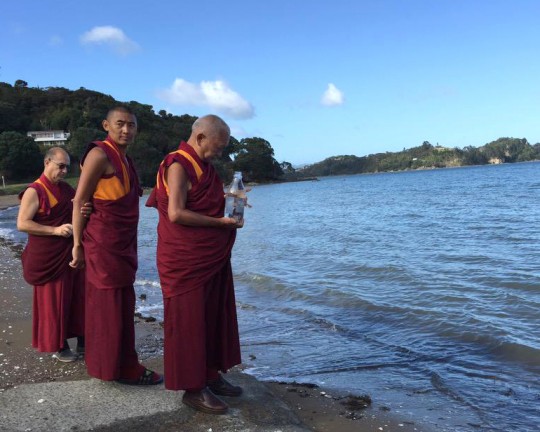
Lama Zopa Rinpoche blessing the sentient beings and ocean on the way to the airport from Mahamudra Centre, New Zealand, May 2015. “[We were] running late!” Ven. Roger Kunsang shares when posting the photo on his Twitter page.
For continuing updates and news from Kopan Monastery and other FPMT centers and projects in Nepal affected by the earthquake, please visit our “Updates from Nepal after the Earthquake” page:
https://fpmt.org/nepal-earthquake/
To learn more and offer support to the Nepal Earthquake Support Fund visit:
https://fpmt.org/support/socialservices/
For “Prayers and Practice for Earthquake in Nepal,” see:
https://fpmt.org/edu-news/prayers-and-practices-for-earthquake-in-nepal/
More information, photos and updates about FPMT spiritual director Lama Zopa Rinpoche can be found on Rinpoche’s homepage. If you’d like to receive news of Lama Zopa Rinpoche via email, sign up to Lama Zopa Rinpoche News.
- Tagged: lama zopa rinpoche, new zealand, video
- 0
12
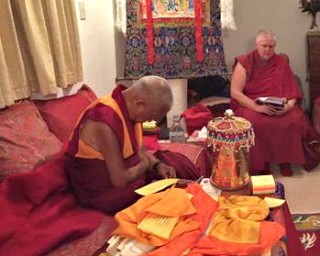
Lama Zopa Rinpoche doing prayers at Mahamudra Centre, New Zealand, May 2015. Photo by Ven. Roger Kunsang.
A second big earthquake has hit Nepal. Ven Roger Kunsang writes from New Zealand:
“The earthquake hit near Everest and Namche [in Solu Khumbu quite close to Lawudo and Thame]. The first measured 7.4, and then there was another soon after. I have talked to Kopan and others in Nepal, and in brief, this is what we know so far in relation to FPMT:
- Kopan and Khachoe Ghakyil monks and nuns are all fine (the ones who were at the monastery and nunnery); buildings have more damage … cracks are bigger in some place, but nothing actually collapsed.
- Lawudo – Ani-la Ngawang Samten (Rinpoche’s sister) and others, no serious harm but shaken up a little. Ani-la said a lot of damage this time in Khumbu area. The main gompa at Lawudo has collapsed … the wall on the kitchen side, other damage also in other areas of Lawudo. Now the place is in a pretty bad state.
- Ganden Yiga Chozin, Pokhara – Drolkar says she and others are fine.
- Thame area … more houses collapsed, so far have not heard of serious harm or deaths.
- Other areas … Tsum, Chailsa and Himalayan Buddhist Meditation Centre … haven’t got updates yet.
- Kathmandu has had a lot of houses and buildings collapse … initially they are saying that there seems to be more damage than the first quake … they say many of the houses that got damaged but didn’t collapse now have collapsed.
People were just starting to get moving again … now they are really shaken up … the reality of possibly more to come is strong.”
Ven. Fran writes from Kopan Monastery:
“We are all okay, sitting in the garden and making jokes how we are now earthquake-qualified.
But it was scary again, nearly as strong as the first one. No more additional damage at Kopan, but in Kathmandu, a lot of half broken houses now completely collapsed. We could see the dust clouds rising directly after the earthquake.”
Kopan Monastery shared on Facebook:
“Lot of houses collapsed and many fresh damages occurred. Kopan monks went immediately to help at a three-story house that collapsed at Kopan, ward 13. People returned back to open places as quake occurred 8 times within a few-hour interval.”
Lama Zopa Rinpoche has been doing prayers with students in New Zealand.
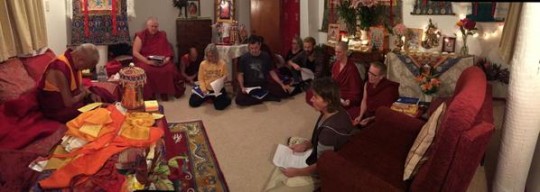
Lama Zopa Rinpoche with students doing prayers after hearing about second big earthquake in Nepal, Mahamudra Centre, New Zealand, May 2015. Photo by Ven. Roger Kunsang.
For “Prayers and Practice for Earthquake in Nepal,” see:
https://fpmt.org/edu-news/prayers-and-practices-for-earthquake-in-nepal/
You can read more details of how FPMT is assisting with short-term and long-term aid to Nepal.
To offer support to the Nepal Earthquake Support Fund visit:
https://fpmt.org/support/socialservices/
For continued news from Nepal, see our Updates from Nepal After the Earthquake:
https://fpmt.org/nepal-earthquake/
- Tagged: earthquakes, lama zopa rinpoche, nepal, nepal earthquake
- 0
11
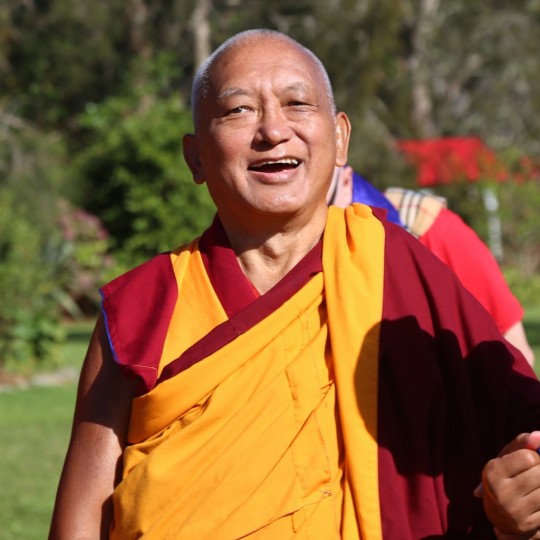
Lama Zopa Rinpoche on the way to consecrate the stupa at Mahamudra Centre, Colville, New Zealand, May 2015. Photo by Ven. Thubten Kunsang.
Lama Zopa Rinpoche began teaching in New Zealand over the weekend at Mahamudra Centre. Rinpoche taught on “Working for Peace – Pacifying Inner and Outer Turmoil.”
Rinpoche also reconsecrated the stupa at Mahamudra Centre. Due to water leaking into the central chamber of the stupa and creating serious damage to the contents, the stupa had to be repaired and resealed as well as completely refilled and redecorated in 2012.
Video of Rinpoche’s teaching at Mahamudra Centre is available for streaming.
https://new.livestream.com/accounts/2729219/events/4036091/videos/86698953/player?width=560&height=315&autoPlay=false&mute=false
Rinpoche will remain in New Zealand for three weeks, giving teachings at Chandrakirti Centre, Dorje Chang Institute and Amitabha Hospice Service. Rinpoche is scheduled to travel next to Australia as part of his eight-country tour that runs through the end of September. For more details, please see Lama Zopa Rinpoche’s Schedule on FPMT.org.
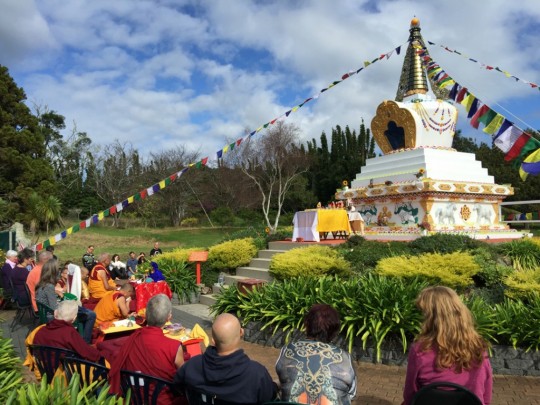
Lama Zopa Rinpoche consecrating stupa at Mahamudra Centre, New Zealand, May 2015. Photo by Ven. Thubten Kunsang.
For continuing updates and news from Kopan Monastery and other FPMT centers and projects in Nepal affected by the earthquake, please visit our “Updates from Nepal after the Earthquake” page:
https://fpmt.org/nepal-earthquake/
Learn more on FPMT.org about our Social Service Fund, which includes emergency relief and rebuilding in Nepal. To make a donation to the Nepal Earthquake Support Fund visit:
https://fpmt.org/support/socialservices/
More information, photos and updates about FPMT spiritual director Lama Zopa Rinpoche can be found on Rinpoche’s webpage. If you’d like to receive news of Lama Zopa Rinpoche via email, sign up to receive FPMT News.
- Tagged: lama zopa rinpoche, mahamudra centre, video
- 0
8
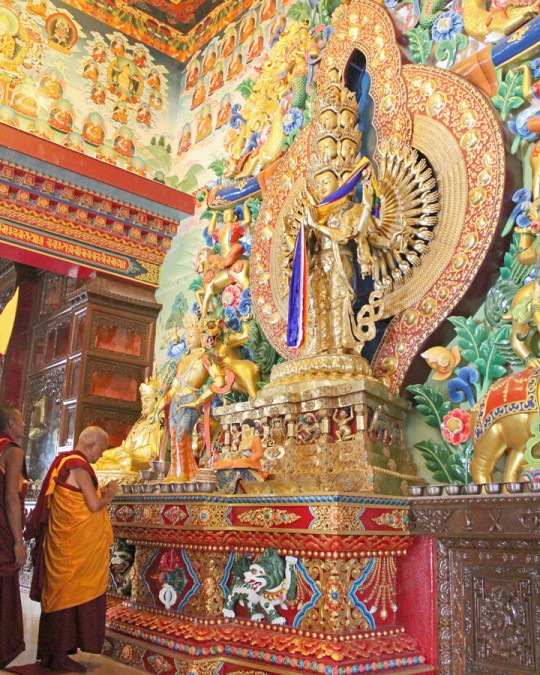
Lama Zopa Rinpoche in front of a Thousand-Armed Chenrezig statue, which is the main statue in the new gompa at Kopan Nunnery, Nepal, April 30, 2015. Photo by Ven. Lobsang Sherab.
“The benefits of reciting the Compassion Buddha mantra are infinite, like the limitless sky,” Lama Zopa Rinpoche said in July 2000.
“Even if you don’t have much intellectual understanding of Dharma, even if the only thing you know is OM MANI PADME HUM, still the happiest life is one lived with an attitude free of the eight worldly concerns. If you live your life with the pure attitude free of attachment clinging to this life and simply spend your life chanting OM MANI PADME HUM – this six-syllable mantra that is the essence of all Dharma – that’s the purest Dharma.
“It looks very simple, very easy to recite. But if you think of the benefits, it’s not at all simple. Here, I’d like to mention just the essence of its infinite benefits.
“Reciting the Compassion Buddha mantra just once completely purifies the four defeats of breaking the four root vows of self-liberation and the five uninterrupted negative karmas.
“It is also mentioned in the tantras that by reciting this mantra you achieve the four qualities of being born in the Amitabha Buddha pure land and other pure lands; at the time of death, seeing Buddha and lights appearing in the sky; the devas making you offerings; and never being reborn in the hell, hungry ghost or animals realms. You will be reborn in the pure land of Buddha or as a happy transmigratory being.
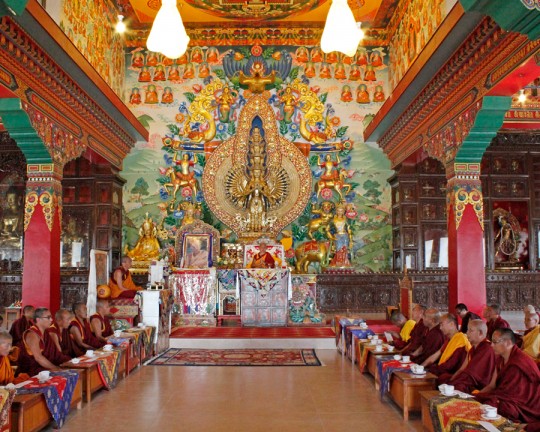
Lama Zopa Rinpoche opening the new gompa at Khachoe Ghakyil Nunnery, the Kopan nunnery, after the earthquake, April 30, 2015. Photo by Ven. Lobsang Sherab.
“When one who recites 10 malas a day goes swimming, whether in a river, an ocean or some other body of water, the water that touches that person’s body gets blessed.
“It is said that up to seven generations of that person’s descendants won’t get reborn in the lower realms. The reason for this is that due to the power of mantra, the body is blessed by the person reciting the mantra and visualizing their body in form of the holy body of Chenrezig. Therefore, the body becomes so powerful, so blessed that this affects the consciousness up to seven generations and has the effect that if one dies with a non-virtuous thought, one is not reborn in a lower realm.
“Thus, when a person who has recited 10 malas of OM MANI PADME HUM a day goes into a river or an ocean, the water that touches the person’s body gets blessed, and this blessed water then purifies all the billions and billions of sentient beings in the water. So it’s unbelievably beneficial; this person saves the animals in that water from the most unbelievable suffering of the lower realms.
“When such a person walks down a road and the wind touches his or her body and then goes on to touch insects, their negative karma gets purified and causes them to have a good rebirth. Similarly, when such a person does massage or otherwise touches others’ bodies, those people’s negative karma also gets purified.
“Such a person becomes meaningful to behold; being seen and touched becomes a means of liberating other sentient beings. This means that even the person’s breath touching the bodies of other sentient beings purifies their negative karma. Anybody who drinks the water in which such a person has swum gets purified. …”
You can read the entire teaching from Lama Zopa Rinpoche on “The Benefits of Chanting OM MANI PADME HUM,” part of FPMT Education Services “Mantras” resource pages.
Learn more about Lama Zopa Rinpoche, spiritual director of the Foundation for the Preservation of Mahayana Tradition (FPMT), and Rinpoche’s vision for a better world. Sign up to receive news and updates.
- Tagged: lama zopa rinpoche, mani mantra
- 0
5
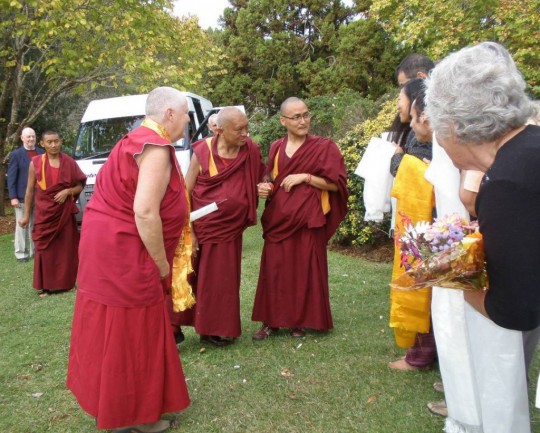
Lama Zopa Rinpoche arriving at Mahamudra Centre in Colville, New Zealand, May 5, 2015. Photo courtesy of Mahamudra Centre for Universal Unity on Facebook.
Lama Zopa Rinpoche arrived at Mahamudra Centre, in Colville, New Zealand, which is on the Coromandel Peninsula on New Zealand’s North Island. On May 9-10, Rinpoche is scheduled to teach at Mahamudra Centre on ”Working for Peace – Pacifying Inner and Outer Turmoil.”
Rinpoche will remain in New Zealand for three weeks, giving teachings at Chandrakirti Centre, Dorje Chang Institute and Amitabha Hospice Service. Rinpoche is scheduled to travel next to Australia as part of his eight country tour that runs through the end of September. For more details, please see Lama Zopa Rinpoche’s Schedule on FPMT.org.

Losang Namgyal Rinpoche and volunteers from the Namgyal Rinpoche Foundation, Kathmandu, Nepal, May 2015. Photo courtesy of Losang Namgyal Rinpoche on Facebook.
Losang Namgyal Rinpoche, a Kopan monk and a lama for the Tamang people, oversees the Namgyal Rinopche Foundation, which has organize much emergency aid and relief for earthquake victims and has been coordinating efforts with Kopan Monastery. He shared this message on Facebook:
“Thank you very much to all volunteers and those who are supporting those noble causes. I’m very moved to see our members helping tirelessly everyday. I also like to thank my Guru Kyabje Lama Thupten Zopa Rinpoche and FPMT for kind help. Thukje Che.”
Kopan Monastery continues its emergency relief work, traveling hours outside of Kathmandu to deliver supplies to earthquake-affected people. You can find more about their work on the Kopan Monastery School Facebook page.
For more updates and news from Kopan Monastery and other FPMT centers and projects in Nepal affected by the earthquake, visit our “Updates from Nepal after the Earthquake” page:
https://fpmt.org/nepal-earthquake/
To learn more and offer support to the Nepal Earthquake Support Fund visit:
https://fpmt.org/support/socialservices/
For “Prayers and Practice for Earthquake in Nepal,” see:
https://fpmt.org/edu-news/prayers-and-practices-for-earthquake-in-nepal/
Visit FPMT’s Facebook page to find more frequent updates and news.
More information, photos and updates about FPMT spiritual director Lama Zopa Rinpoche can be found on Rinpoche’s webpage. If you’d like to receive news of Lama Zopa Rinpoche via email, sign up to Lama Zopa Rinpoche News.
- Tagged: lama zopa rinpoche, mahamudra centre, nepal earthquake
- 0
4
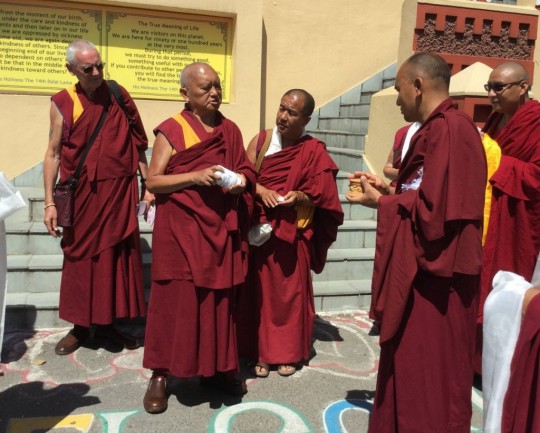
Lama Zopa Rinpoche departing from Kopan Monastery, Nepal, May 4, 2015. Photo by Ven. Sarah Thresher.
After completing the Most Secret Hayagriva initiation late at night on May 3, Lama Zopa Rinpoche departed from Kopan Monastery in Nepal on May 4 to begin a worldwide teaching tour. Rinpoche travels first to New Zealand’s Mahamudra Centre, where he is scheduled to teach May 9-10.
The Most Secret Hayagriva initiation at Kopan Monastery had been scheduled for April 27-30. Even after the devastating earthquake of April 25, Rinpoche decided to offer the initiation, which was given in the main gompa at Kopan Monastery, beginning on the evening of May 2.
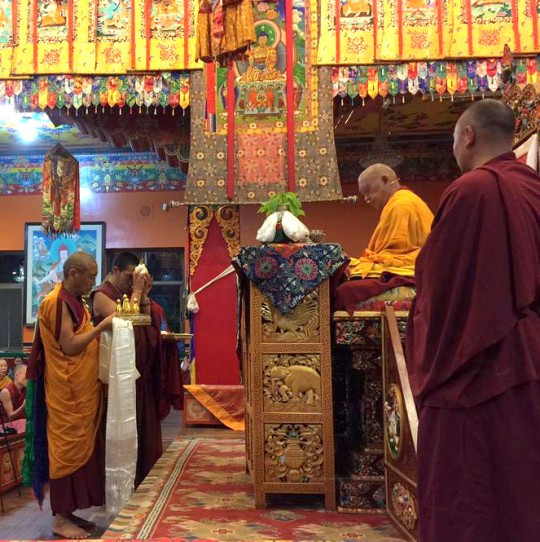
Khen Rinpoche Geshe Chonyi offering the mandala to Lama Zopa Rinpoche at the beginning of the Most Secret Hayagriva initiation, Kopan Monastery, Nepal, May 2, 2015. Photo by Ven. Roger Kunsang.
Kopan Monastery monks continue to lead emergency relief efforts, going out to offer aid packages to people in villages outside of Kathmandu. They are coordinating their efforts with Losang Namgyal Rinpoche‘s organization and together hundreds of families are receiving emergency aid in a direct and organized way.
On May 1, the first shipment of aid arrived in Thame, the birthplace of Lama Zopa Rinpoche located near Lawudo Gompa in the remote Solu Khumbu district. Five Kopan monks traveled with the supplies, which were flown to Lukla and then helicoptered to Thame. The monks helped organize the distribution of tents for 190 families. Most structures in the area received significant damage making them uninhabitable.
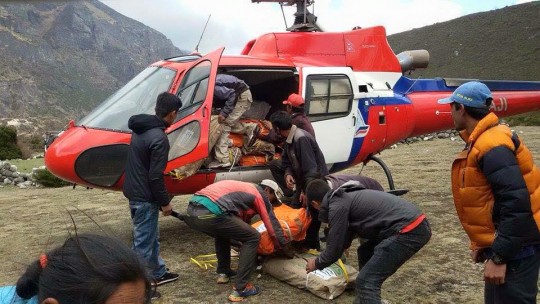
Emergency relief supplies arriving in Thame, Solu Khumbu district, Nepal. May 1, 2015. Photo courtesy of Tara Melwani on Facebook.
Lama Zopa Rinpoche offered US$50,000 through FPMT’s Nepal Earthquake Support Fund for emergency relief in Thame. Cherok Lama Sherpa, who is also from the area, is raising money and contributing to this relief effort as well. A second shipment of food is being organized and will be delivered as soon as possible. Cherok Lama Sherpa will be arriving in the area this week to personally offer help and view the destruction.
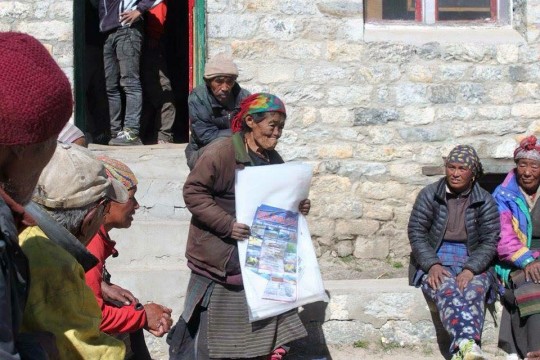
Relief supplies being distributed in Thame, Nepal, May 1, 2015. Photo courtesy of Tara Melwani on Facebook.
For the latest updates and news from Kopan Monastery and other FPMT centers and projects in Nepal affected by the earthquake, visit our “Updates from Nepal after the Earthquake” page:
https://fpmt.org/nepal-earthquake/
To learn more and offer support to the Nepal Earthquake Support Fund visit:
https://fpmt.org/support/socialservices/
For “Prayers and Practice for Earthquake in Nepal,” see:
https://fpmt.org/edu-news/prayers-and-practices-for-earthquake-in-nepal/
More frequent updates and news can be found on FPMT’s Facebook page.
More information, photos and updates about FPMT spiritual director Lama Zopa Rinpoche can be found on Rinpoche’s webpage. If you’d like to receive news of Lama Zopa Rinpoche via email, sign up to Lama Zopa Rinpoche News.
- Tagged: kopan monastery, lama zopa rinpoche, nepal earthquake, nepal earthquake relief fund, thame
- 0
1
As the shaking of the ground in Nepal tapers off and electricity returns to Kathmandu, relief efforts have been moving forward. Ven. Roger Kunsang shared that the first aid shipment to Thame arrived on May 1.
Lama Zopa Rinpoche offered US$50,000 in initial emergency aid through FPMT’s Nepal Earthquake Support Fund to help families in the Thame area. Thame, located near Lawudo in Solu Khumbu, is Rinpoche’s place of birth and nearly all buildings there were destroyed by the earthquake. (You can find photos of the destruction here.) The location is remote and difficult to reach.
Rinpoche’s brother Sangay Sherpa, who directs the Lawudo Gompa and Retreat Centre, and Ven. Nyima Tashi primarily organized the effort. The first shipment, which included tent material for more than 190 families, was flown to Lukla and then helicoptered to Thame. It arrived safely along with five Kopan monks to help manage the distribution. The flight to Lukla was sponsored by Goma Air. Charok Lama Sherpa, who is a 22-year-old rinpoche studying at Sera Monastery, is also from the area and helping sponsor the relief. He will be traveling to the area next week and will personally oversee the relief activities.
The next shipment to go up is for food supplies for one month for all 190 families. Food will take longer to get up there. Ven. Roger said, “gathering materials and food is very difficult as there are shortages.”
The monks from Kopan Monastery have been very active distributing food and water locally and in the areas around Kathmandu. Some of the young monks got involved, donating their blankets to earthquake victims, according to Ven. Thubten Jinpa.
“Kopan monks are going to one of the hardest hit places tomorrow,” Ven. Roger said. “It is one day’s drive to get there and back, they are delivering food, blankets and clothing.” Kopan Monastery described some of their relief work from today on Facebook:
“We loaded more than 100 sacks of rice, dal, salt and oil and went to distribute in Chapagaon, ward 7 [a village south of Kathmandu]. Meanwhile another group was set up for cleaning. There’s fear of the spread of disease, which often happens after earthquakes. We cleaned the most affected area of Kopan village.
“We witnessed that normality among the people came much better than other days. Shops are opened, restaurants are opening, normal life is returning slowly in the valley. We know there are still many places outside the valley where people need lots of helps, especially around the Sindupalchok district, where more than 1,800 are dead and around 3,000 missing.
“Still it is a little confusing about what really they need. Tents are for sure, because those people whose homes got affected need to stay outside till they get recovered. Maybe they may need food and blankets. So, we’re looking forward to prepare those things as much as we can and will head tomorrow to those areas. We decided to send two groups, one to the Sindupalchok and other one to Rasuwa.”

Losang Namgyal Rinpoche with workers from the Namgyal Rinpoche Foundation and aid to be delivered to Tamang communities, Kathmandu, Nepal
Losang Namgyal Rinpoche, a Kopan monk and a lama for the Tamang people, one of the largest ethnic groups in Nepal, has for several years been doing work through the Namgyal Rinpoche Foundation in remote areas, building schools and creating stupas. (This work has been supported in part by Lama Zopa Rinpoche through the Lama Zopa Rinpoche Bodhichitta Fund.) Their teams are now very active in relief efforts, sending aid to different parts, including as many remote districts as they are able to get to. The Tamang, who are Buddhist, may have experienced devastating losses from the earthquake as they live in very remote mountainous areas and are often very poor.
Lama Zopa Rinpoche is also going to help Losang Namgyal Rinpoche with supplies for Tamang people. Losang Namgyal Rinpoche shared on Facebook on May 1 a short report on the situation:
“Now we receive requests for supplies from many villages, but we are still unable to help. Only some has been benefited. We try our best to help all. We are here for long-term helping, so there are many things we have to be aware of as there are terms and conditions from the government. We will continue to assist no matter what. We cannot give out all, it has to be organized. Many are receiving help already. It can three months at least to know the all the casualties. After that, it take from a year to 7 years to complete, so long way to go. ….”
Phil Hunt, a coordinator of the Animal Liberation Sanctuary, which is a project of Kopan Monastery, has been sharing his reports on the work being done to look after animals in the wake of the earthquake on his news blog for Tree of Compassion. The animals at the sanctuary came through the earthquake without injury and have the supplies and care they need. Phil and sanctuary manager Pema have been offering assistance as they can to animals throughout the area.
“We had a request to visit the Bhaktapur area where there was extensive damage from the earthquake,” Phil wrote. “Local vet Dr. Pranav had been virtually sleepless dealing with the many animals in distress. His staff had to all go home to help their families. Half a dozen cows with deep lacerations and injuries were treated and some others died. A festival was imminent meaning many people had goats with them to slaughter. He rescued one from the seventh floor of a severely damaged building at great risk. He has had to stop this kind of rescue as damaged buildings are still coming down due to the rain.
“We gave him what medical supplies we could spare and will work to resupply him and support his valuable work in the area. Once the immediate area has been searched and dealt with, we will join in patrols of nearby villages where there has been no veterinary/animal care support at all.”
At the end of the day, Rinpoche teaches and leads prayers at Kopan. And most still retire to sleep in tents and shelters outside.
For the latest updates and news from Kopan Monastery and other FPMT centers and projects in Nepal affected by the earthquake, visit our “Updates from Nepal after the Earthquake” page:
https://fpmt.org/nepal-earthquake/
To learn more and offer support to the Nepal Earthquake Support Fund visit:
https://fpmt.org/support/socialservices/
For “Prayers and Practice for Earthquake in Nepal,” see:
https://fpmt.org/edu-news/prayers-and-practices-for-earthquake-in-nepal/
You can receive an email daily digest of news from FPMT.org, including our updates from Nepal, by signing up at this address:
https://fpmt.us6.list-manage.com/subscribe?u=97e3ebb09472d09e0e699efd3&id=b248a1a45e
More information, photos and updates about FPMT spiritual director Lama Zopa Rinpoche can be found on Rinpoche’s webpage. If you’d like to receive news of Lama Zopa Rinpoche via email, sign up to Lama Zopa Rinpoche News.
30
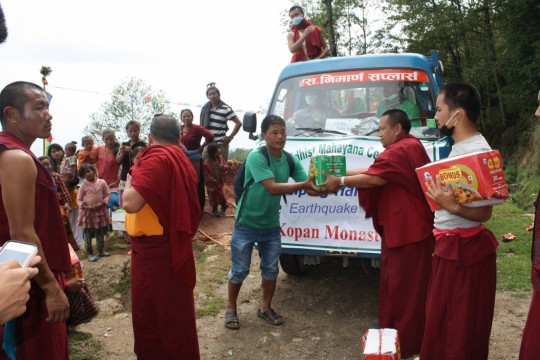
Kopan monks delivering supplies to families in need in the Kathmandu area, Nepal, 30 April 2015. Photo courtesy Kopan Apso on Facebook.
30 April 2015, 10 p.m. Kathmandu time
From Ven. Roger:
Lama Zopa Rinpoche’s teaching was in the gompa due to the rain. Rinpoche taught that the earthquake fear is similar to what we create in Chöd, and that the earthquake came from karma and from our self-cherishing mind. Rinpoche also taught, when someone gets angry at us, we should think this is from our self-cherishing attitude, otherwise we put the blame outside on others; whatever bad things happen to us we should put the blame on our self-cherishing attitude, instead of pointing the finger outside at others. Usually we make friends with our self-grasping and self-cherishing mind and it becomes very hard like stone, Rinpoche said. The three jewels come from sentient beings, all the Buddha came from all the sentient beings.
We are sleeping outside in tents, according to Rinpoche’s observation that this is safer. Day seems OK, but at night, there is still some danger of another aftershock. You still feel minor aftershocks and many people are still nervous. Some shops started to open today which is good because people can buy food.
We received reports and photos from Lawudo Gompa and Retreat Centre today that the quake did do some major damage to the retreat cabins, library and dining area.

Kopan monks loading supplies on to truck for distribution, Kopan Monastery, Nepal, April 30, 2015. Photo courtesy of Kopan Apso Facebook page.
Kopan monks delivered rice and some essentials to local hospitals there were running out of food. [You can read more about the monks tireless work on FPMT.org.]
We have a plane leaving tomorrow loaded with tent material for Thame. Then we have rented a big Russian helicopter to bring food up to Thame. But it’s in a queue, so the helicopter cannot go immediately — there is quite a delay.
Rinpoche is right now doing the Eight Prayers to Benefit the Dead [which you can find on FPMT.org] with the Kopan monks. Every evening Rinpoche with monks do prayers for the dead and sick and injured
Ganden Yiga Chozing Buddhist Meditation Centre, the FPMT center in Pokhara, Nepal, is the only FPMT center or project in Nepal to not receive any damage. All others have serious damage.
Our Nepal Earthquake Support Fund will be used to assist with rebuilding as well as helping with initial emergency needs. Thank you everyone for your kind donations so far to the fund! We are already using it with the US$50,000 of aid going to Thame. You can make a donation at: https://fpmt.org/support/socialservices/
Rinpoche, through the Nepal Earthquake Support Fund, has also offered $30,000 to Charok Lama Sherpa, who is coordinating another $50,000 of aid to be taken up to the Solu Khumbu region close to Lawudo. Charok Lama is also from this area and will be traveling soon from Sera Je Monastery in India, where he is studying, to Nepal.
For the latest updates and news from Kopan Monastery and other FPMT centers and projects in Nepal affected by the earthquake, visit our “Updates from Nepal after the Earthquake” page:
https://fpmt.org/nepal-earthquake/
To learn more and offer support to the Nepal Earthquake Support Fund visit:
https://fpmt.org/support/socialservices/
For “Prayers and Practice for Earthquake in Nepal,” see:
https://fpmt.org/edu-news/prayers-and-practices-for-earthquake-in-nepal/
You can receive an email daily digest of news from FPMT.org, including our updates from Nepal, by signing up at this address:
https://fpmt.us6.list-manage.com/subscribe?u=97e3ebb09472d09e0e699efd3&id=b248a1a45e
More information, photos and updates about FPMT spiritual director Lama Zopa Rinpoche can be found onRinpoche’s webpage. If you’d like to receive news of Lama Zopa Rinpoche via email, sign up to Lama Zopa Rinpoche News.
- Tagged: charok lama, kopan monastery, lama zopa rinpoche, lawudo, nepal earthquake, nepal earthquake support fund, thame
- 0
29
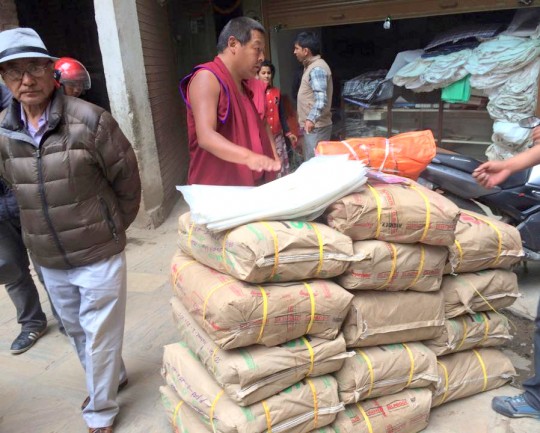
Sangey Sherpa, Lama Zopa Rinpoche’s brother and director of Lawudo Gompa and Retreat Centre, and Ven. Nyima Tashi with supplies that are being flown up to Thame, which is near Lawudo in the Solu Khumbu district, Kathmandu, Nepal, April 29, 2015
29 April 2015, 1 p.m. Kathmandu
From Ven. Roger Kunsang:
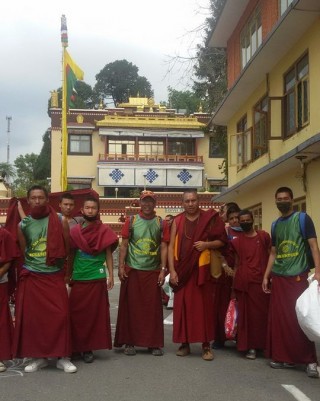
Emergency relief volunteers, some will be traveling to Thame with food and shelter for families there, Kopan Monastery, April 29, 2015. Photo by Tara Melwani.
So many people have been affected and many seriously. It’s an impossible job to help everyone at the same time.
The government with the support of many overseas and local organizations are prioritizing the worst-affected areas with what resources are available. One of the key issues is the remoteness and high altitude of many of the areas … and being cut off by landslides.
Rinpoche is focusing on Thame, his birthplace [near Lawudo Gompa in the Solu Khumbu district], and some of the other nearby areas to Lawudo, which is Rinpoche’s “local community,” so to speak.
In this area, there are about 100 families (our estimate so far, telephones are not working as yet, so communication is very difficult up there and still also hard in Kathmandu valley) who have lost their homes, and a few have been killed. They are living under plastic sheets huddled together as it is very cold and wet. There are still a few house standing, but people are too scared to go into them in case there is an aftershock. Food is running out.
Today we are organizing 100 food and shelter packages (basic food and a tent for each family). Each package is US$500, so a total of $50,000. This money is the first disbursement from FPMT’s Nepal Earthquake Support Fund.
Thank you for everyone’s support thus far. There is definitely more assistance required. So if you can help, it is greatly needed. And we are now able to directly offer immediate help.
We hope we can get a helicopter (all are commandeered by the government) to make several trips up to Thame, which is remote and at about 4,000 meters [13,100 feet]. This will help them get through the initial stage until, we hope, the bigger agencies and governments arrive with aid.
Most of the Kopan monks and nuns are now out helping in the affected areas, especially trying to get water and basic food to people. Some of the Westerners who are staying here are with them helping. The monks and nuns at Kopan are often from remote areas and some are trying to get back to help the older people. A lot of remote areas just have older people living there as the young come into Kathmandu to find work or go overseas for work.
There has been a lot of confusion and it’s very disorganized. That will improve. In the meantime, lives are lost and others are in need or hurt badly. Especially in difficult to reach mountainous regions, it’s really bad.
In the evenings Rinpoche with the Sangha are doing many prayers and pujas for those who have died and hurt as well as pujas to prevent further aftershocks.
One of the difficulties is getting people back to work. People are too scared to go into buildings in case there are more aftershocks. Shops don’t open and people can’t buy food and other necessities. Or the workers have left to help their families in outlying areas. Still soon they will be forced to open as people mostly live day to day. They have to work to buy food. Still many are living in tents in open areas.
People really got scared due to how violent the main two earthquakes were. Most people who died or were seriously hurt were killed or injured due to badly built buildings or very old buildings collapsing on them. I had a wall collapse on me while having a meeting. And I was lucky to receive just minor cuts and bruises, nothing really compared to many others.
Kopan Monastery and Nunnery have suffered a lot of damage. The engineers will come soon and let us know the extent and seriousness of the damage.
Today Rinpoche is moving back into the main monastery building. Hopefully that means no more serious aftershocks. And overhead there is the constant sound of helicopters shuttling back and forth with injured people or supplies. It’s constant as there are smaller light aircraft doing the same.
Jimmy Grant visited Thame not long after the earthquake. Here is his eyewitness account of the area, shared in an email to his father:
Yesterday [April 28, 2015], I went to visit Thame, in the hope of contacting you and spending some time at the lodge. I was absolutely heartbroken by what I saw and what’s worse is that Thame, from what I have seen, has yet to receive any assistance from anyone. I started talking to a young boy named Mingma, who took me to his house. You can see him in one of the pictures attached. I also met the little girl you can see in another picture near her home. The lodge is still standing, but has some serious damage. I wouldn’t stand inside of it, that’s for sure. Oh and Lama Zopa Rinpoche’s house is pretty well completely gone.

Young girl stands next to a collapsed home in Thame, Solu Khumbu district, Nepal, April 28, 2015. Photo by Jimmy Grant.
For the latest updates and news from Kopan Monastery and other FPMT centers and projects in Nepal affected by the earthquake, visit our “Updates from Nepal after the Earthquake” page:
https://fpmt.org/nepal-earthquake/
To learn more and offer support to the Nepal Earthquake Support Fund visit:
https://fpmt.org/support/socialservices/
For “Prayers and Practice for Earthquake in Nepal,” see:
https://fpmt.org/edu-news/prayers-and-practices-for-earthquake-in-nepal/
You can receive an email daily digest of news from FPMT.org, including our updates from Nepal, by signing up at this address:
https://fpmt.us6.list-manage.com/subscribe?u=97e3ebb09472d09e0e699efd3&id=b248a1a45e
More information, photos and updates about FPMT spiritual director Lama Zopa Rinpoche can be found on Rinpoche’s webpage. If you’d like to receive news of Lama Zopa Rinpoche via email, sign up to Lama Zopa Rinpoche News.
- Home
- News/Media
- Study & Practice
- About FPMT Education Services
- Latest News
- Programs
- New to Buddhism?
- Buddhist Mind Science: Activating Your Potential
- Heart Advice for Death and Dying
- Discovering Buddhism
- Living in the Path
- Exploring Buddhism
- FPMT Basic Program
- FPMT Masters Program
- FPMT In-Depth Meditation Training
- Maitripa College
- Lotsawa Rinchen Zangpo Translator Program
- Universal Education for Compassion & Wisdom
- Online Learning Center
- Prayers & Practice Materials
- Overview of Prayers & Practices
- Full Catalogue of Prayers & Practice Materials
- Explore Popular Topics
- Benefiting Animals
- Chenrezig Resources
- Death & Dying Resources
- Lama Chopa (Guru Puja)
- Lama Zopa Rinpoche: Compendium of Precious Instructions
- Lama Zopa Rinpoche: Life Practice Advice
- Lama Zopa Rinpoche Practice Series
- Lamrim Resources
- Mantras
- Prayer Book Updates
- Purification Practices
- Sutras
- Thought Transformation (Lojong)
- Audio Materials
- Dharma Dates – Tibetan Calendar
- Translation Services
- Publishing Services
- Teachings and Advice
- Find Teachings and Advice
- Lama Zopa Rinpoche Advice Page
- Lama Zopa Rinpoche: Compendium of Precious Instructions
- Lama Zopa Rinpoche Video Teachings
- ༧སྐྱབས་རྗེ་བཟོད་པ་རིན་པོ་ཆེ་མཆོག་ནས་སྩལ་བའི་བཀའ་སློབ་བརྙན་འཕྲིན།
- Podcasts
- Lama Yeshe Wisdom Archive
- Buddhism FAQ
- Dharma for Young People
- Resources on Holy Objects
- Ways to Offer Support
- Centers
- Teachers
- Projects
- Charitable Projects
- Make a Donation
- Applying for Grants
- News about Projects
- Other Projects within FPMT
- Support International Office
- Projects Photo Galleries
- Give Where Most Needed
- FPMT
- Shop
Translate*
*powered by Google TranslateTranslation of pages on fpmt.org is performed by Google Translate, a third party service which FPMT has no control over. The service provides automated computer translations that are only an approximation of the websites' original content. The translations should not be considered exact and only used as a rough guide.Living in morality is one fundamental spiritual practice that is a very important source of happiness for you and for all living beings. This is also one of the best contributions that you can give to this world, for world peace.







